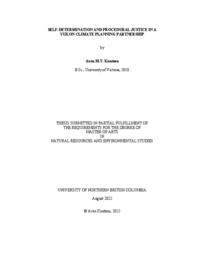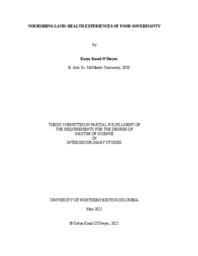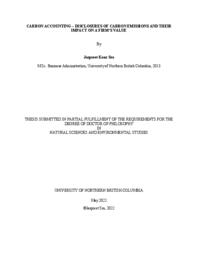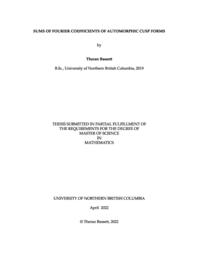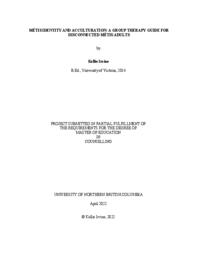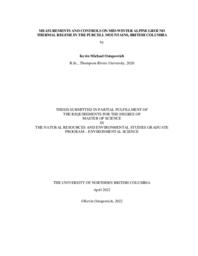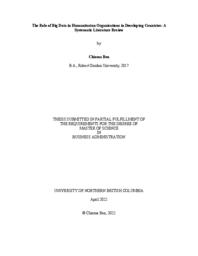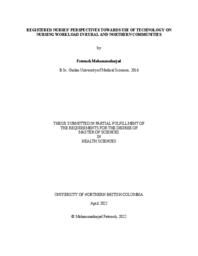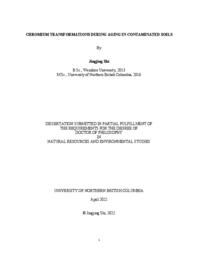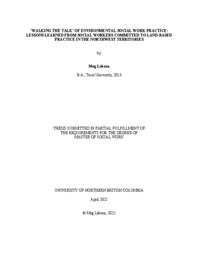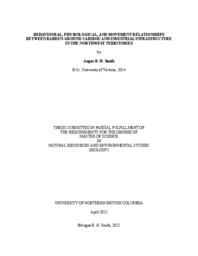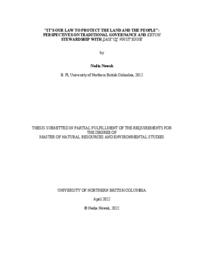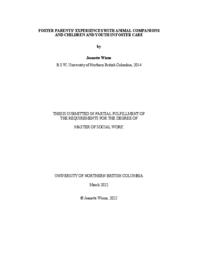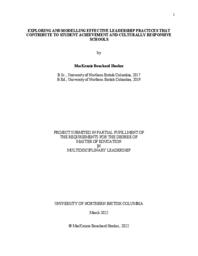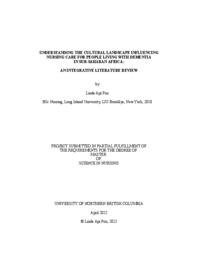University of Northern British Columbia
Related Works
Content type
Digital Document
Description / Synopsis
Planning for community resilience and climate change requires new forms of engagement that are accountable to Indigenous peoples and the social and cultural upheavals associated with colonial harm. This thesis shows that climate governance requires partnerships and policy actions that reflect needs and priorities of communities in specific geographic, political, and cultural contexts. As a case study, it examines the development of the 2020 Our Clean Future (OCF) strategy by Government of Yukon and Indigenous partners. Through semi-structured interviews and document studies, the research applies a theoretical lens of procedural justice and self-determination to the OCF process. Outcomes from this research offer a set of policy cycle considerations and recommendations for future environmental planning partnerships that include taking a rights-based approach, increasing capacity for collaboration in multiple areas, stronger integration of culturally diverse ways of knowing and doing, and targeted urban Indigenous engagement. Findings suggest OCF can serve as a useful procedural policy tool that supports Indigenous self-determination if lessons learned from the process are carried forward in future environmental planning partnerships.
Origin Information
Content type
Digital Document
Description / Synopsis
The widespread availability of Cross-laminated timber (CLT) provides opportunities to extend the use of wood beyond traditional low-rise residential construction. Although previous studies have shown that ground motion duration impacts the collapse risk of structural systems, duration effects are not explicitly accounted for in current building codes, and information on the impact of ground motion duration on the seismic performance of CLT buildings is not available. This study aims to quantify the effects of long duration ground motions on a newly constructed two-storey balloon-type CLT building located in Vancouver, Canada. A three-dimensional numerical model of the building was developed in OpenSees. The shear wall and connections models were validated with test data. 24 pairs of long and short duration records with approximately the same amplitude, frequency content and the rate of energy build up were used for nonlinear dynamic analyses. The building was subjected to the earthquakes in its long (weak) direction. To assess the building’s collapse capacity, fragility curves were developed based on incremental dynamic analysis. The long and short duration motions on average resulted in interstorey drift ratios of 3.7% and 4.8%, respectively, before collapse, indicating that long duration motions are more likely to lead to structural collapse. Similarly, compared with short duration motions, long duration motions increased the probability of collapse by 7% due to the larger number of inelastic cycles. These results suggest that further research is required to further evaluate the effect of ground motion duration on the seismic performance of CLT buildings.
Origin Information
Content type
Digital Document
Description / Synopsis
Indigenous food sovereignty— a living reality prior to colonization, which violently disrupted Indigenous food systems—is characterized by Indigenous peoples’ self-determination in controlling their food systems and culturally informed foods practices. Directly related to ongoing coloniality, food insecurity is central to the disproportionately high burdens of poor health affecting Indigenous peoples. By exploring the health-related experiences of food sovereignty and Indigenous food sovereignty leaders living in northern BC, this project asks both: How does engaging in food sovereign practices affect peoples’ health? What are the factors that foster (or limit) food sovereignty practices? Being sensitive to past and ongoing colonial and paternalistic research approaches, this research enacts a community-informed ethos, anchored in community-based participatory research (CBPR) processes, wherein research is conducted with and for those involved. This research draws on qualitative methods, including semi-structured (virtual) interviews with community members and knowledge holders, including diverse food sovereignty and Indigenous food sovereignty champions. Champions are involved in various capacities, including direction of research design, engaging in interviews, and informing research outputs. Addressing gaps in the literature, this research documents holistic health experiences of food sovereignty and Indigenous food sovereignty leaders in northern BC. By highlighting experiences faced by those enacting food sovereignty practices, this research offers a counterview to existing bodies of food and health-related research and literature that rely predominantly on quantitative food security metrics. This project’s findings contribute to a growing body of scholarship documenting food sovereignty praxis: the work thus has the potential to inform policy that helps to support the resilience and self-determination of those doing food sovereignty and Indigenous food sovereignty.
Origin Information
Content type
Digital Document
Description / Synopsis
Environmental sustainability is key to the long-term sustainability of a business during these times of climate change crises and global warming. Otherwise, survival will be challenging for large carbon emitters. This dissertation travels through carbon accounting to carbon reporting to corporate level environmental sustainability efforts and a firm’s value. It examines whether the corporation-level environmental sustainability efforts increase its value, focusing on Global 500 companies for 2010-2018. Measures used for corporate-level ecological sustainability include the choice of voluntary disclosure, carbon emission amounts, carbon intensity, and carbon disclosure quality. Different proxies used to measure a firm’s value comprise the market value of equity, return on assets, return on equity, Tobin’s Q, and enterprise value. During the study period, those corporations that chose to disclose their carbon-related data on the CDP’s public platform noticed that the market valued their environmental sustainability efforts by increasing their market value – showing the market value-relevant content of voluntary carbon disclosures. Carbon disclosure quality stands out among the proxies used to measure environmental sustainability efforts at a corporate level. Some interesting findings showed that measuring and disclosing Scope 3 emissions must have played a significant role in increasing a firm’s disclosure quality and so its market value. Similar to Assidi's research, this study provides guidelines for investors and managers to increase a firm’s value by using better quality carbon disclosures. This study also compared the firm’s value of disclosing and non-disclosing firms and, unfortunately, did not find any significant relationship between a company’s disclosure decision and market value in the context of global companies. These results are alarming given the current and potential hazards related to climate change and global warming. It seems that investors ignore climate-related urgency and focus on short-term profits. Companies do not find any incentives to reveal their environmental-related information on any public platform such as the CDP. This study examined and found that social pressure, market pressure, economic pressure, legal/institutional pressure, and previous year disclosure make the companies disclose their carbon information to the CDP. Based on the sample of the Global 500, the results support the notion that larger firms are aware of their social responsibility. So, they disclose environmental-related information voluntarily even in the absence of any mandatory requirement. Furthermore, high-levered firms are more likely to release their carbon-related information. However, the results report that a large proportion (25%) of the sample companies chose not to disclose carbon information. Also, this study showed that regulatory provisions had an observable influence on a company’s disclosing decision. These policies can force companies to reduce carbon emissions and make carbon disclosures their strategic priority. This study emphasized the impact of carbon disclosures, related information, their link to a firm’s value, and corporate-level environmental sustainability efforts. It also posits that corporation-level carbon disclosures can be a prerequisite to corporation-level ecological sustainability. In addition, these disclosures can serve as necessary and valuable environmental-related information for existing and potential investors and other interested stakeholders such as nongovernmental organizations (NGOs), governments, policymakers, accountants, sustainability experts, and researchers. On positive notes, around fifty-five percent of the corporations whom CDP approached for their environmental-related disclosures in 2010 reported to the CDP for the study period, to indicate that these firms are already in the war against climate change and working on business and environmental sustainability. Moreover, these efforts could pay off more in a mandatory environmental-related disclosure regime provided that these disclosures include all scope of emissions. Therefore, this study recommends that environmental-related disclosures be required as part of a company’s annual reports to be more informative for current and potential investors. Moreover, standards of environmental sustainability are needed from standard setters’ bodies to guide the companies to provide consistent and accurate information in their annual reports so that investors can make informed investment decisions.
Origin Information
Content type
Digital Document
Description / Synopsis
Conserving biodiversity is principally achieved through the designation of protected areas, guided by the process of systematic conservation planning (SCP). SCP identifies networks of protected areas that represent regional biodiversity. Ecologists, planners, and decision makers may each use different spatial boundaries, scales, and extents for individual projects; these can be misaligned with the jurisdictional scope and scale of management decisions, impacting the effectiveness of resulting conservation actions. Using British Columbia as a study area, we explore how analysis design effects SCP outputs. Using ILP solvers, we measured concordance, efficiency, and equity between the varying extents (ecological and administrative) and scales (fine, coarse, provincial). Higher efficiency but lower equity results when constraints are lifted. Inversely, higher land requirements with higher equity result when constraints are imposed. We show how initial design decisions influence the priority assigned to conservation areas and find insights for striking a balance between landscape-scale and regional-scale analyses.
Origin Information
Content type
Digital Document
Description / Synopsis
No abstract available.
Origin Information
Content type
Digital Document
Description / Synopsis
Attachment is well established as a fundamental component of long-term partner relationships. Patterns of attachment, between adult partners, hold potential to strengthen or erode the relational bond. Furthermore, partner attachment dynamics have been linked to the long-term emotional and physical wellbeing of both partners. At present, effective in-depth adult attachment resources and interventions are available in various formats. This project adds to the available repertoire of adult attachment resources by providing a three-day introductory retreat focusing on attachment theory fundamentals and skills for developing healthy attachments in relationships. This three-day retreat utilizes interactive partner and group activities along with group therapy sessions. In addition, this couples’ program introduces mindfulness and gratitude practices that support secure partner interactions. This retreat program is intended to be an initial introduction to attachment science and is designed to generate openness and a desire for further engagement with adult attachment resources.
Origin Information
Content type
Digital Document
Description / Synopsis
The Métis are a large population of Indigenous peoples who inhabit Turtle Island, otherwise known as North America. Due to the well-documented deleterious effects of colonization on Indigenous peoples, some Métis remain disconnected from their culture and have grown up with little to no knowledge of their Métis heritage. This project suggests an outline for a Métis-specific group therapy for adults who grew up outside of the community and wish to connect to other Métis in a meaningful way. The project will guide readers through the culturally specific complexities of adopting a Métis identity, as well as suggest methods and perspectives for the Western counsellor to implement in building a positive therapeutic relationship with both Métis individuals and communities.
Origin Information
Content type
Digital Document
Description / Synopsis
Grounded cognition is a theoretical stance that suggests that sensorimotor simulation is constitutive of knowledge. I sought to investigate the role of sensorimotor simulation in higher-level conceptual tasks, such as reading and categorization. Body Ownership Illusions (BOIs) were used to interfere with effector-specific representations. Using Representational Similarity Analysis (RSA) of Electroencephalographic (EEG) data, I identified time points during which representations of different information were active. The neural geometry was compared to two different hypothesized representational geometries. The hypothesized representational geometries were constructed from ratings about effector and sensorimotor information. During the control conditions, two distinct types of information were represented early in the epoch: information about the effector and information about the sensorimotor profile of the word. In the illusion condition, both effector and sensorimotor information representations were pushed to later time points in the epoch. These results demonstrated that sensorimotor and effector information are represented when reading in normal conditions, which supports a weak grounded cognition position, whereby sensorimotor information is activated as we understand concepts. In the illusion conditions, the typical representation of action concepts was disrupted, supporting the hypothesis that BOIs could be used to interfere with concept representation during the understanding of verbs. Effector-specific illusions effects were inconclusive; there was no consistent pattern for hand words in the hand illusion or foot words in the foot illusion. Thus, I did not provide evidence that the information that serves concept representation is effector specific.
Origin Information
Content type
Digital Document
Description / Synopsis
Alpine snow is an important water reservoir for mountain hydrology, climate, ecosystem functions, and has substantial economic value. Snowmelt during spring and summer is driven primarily by incoming shortwave and longwave radiation fluxes, and the ground heat flux is considered to be negligible during this time. However, during the accumulation phase, the ground heat flux may contribute to snowpack thermal conditions and midwinter melt, though this subject has not been studied extensively. The objective of this study is to quantify the alpine ground thermal regime and its relation to topographic setting and the overlying snowpack. The effects of elevation, maximum winter snow depth, snow cover duration, slope, ruggedness, aspect, total potential solar radiation, proximity to glacial ice, and depth of thermistor were evaluated. Four transects consisting of 29 temperature data loggers at the ground-snow interface and one meteorological station collected data from 16 August 2020 to 6 August 2021 at an alpine site in the Purcell Mountains in British Columbia. Snow cover duration, onset, and end-of-winter depths were found to have the greatest influence on the ground thermal regime. Total potential solar radiation had an inverted relation with ground temperatures, however, this was likely related to snow cover duration. Modeled ground heat flux scenarios revealed that snow depth or onset is the most influential of the variables tested. Snow thermal conductivity has the second greatest influence on total ground heat flux, however, true snow thermal conductivity likely varies throughout the winter season and was not measured in this study. Wind has the greatest influence on snow distribution within the Conrad basin with wind scoured slopes coincidentally sharing the same aspect as slopes that receive the greatest total potential solar radiation. There is little evidence to suggest that the ground thermal regime has any influence over the overlying snowpack.
Origin Information
Content type
Digital Document
Description / Synopsis
In response to the exclusion of Indigenous people from natural resources management, the Canadian federal government announced that they would provide $25 million over four years to support the development of Indigenous Guardians programs across Canada. The program was promised to “provide Indigenous Peoples with greater opportunity to exercise responsibility in stewardship of their traditional lands, waters and ice” (Government of Canada 2020). I used a case study approach to explore the role of this funding to support Indigenous communities in their Guardians initiatives. I facilitated semi-structured interviews with staff from five Indigenous Guardians programs from BC and Manitoba, Canada. Participants suggested that the federal pilot program was a step in the right direction to support environmental stewardship initiatives led by Indigenous governments or communities. In particular, this program was successful in increasing monitoring of the land, collaboration with like-minded groups, and facilitating the education of youth by community Elders.
Origin Information
Content type
Digital Document
Description / Synopsis
Being financially and technologically worse off than their counterparts in developed nations, many developing countries face natural disasters that cut them off from the rest of the world and cause excessive damage to invaluable human life and property. Sudden disasters require timely and accurate response from stakeholders to provide immediate relief while deploying scarce resources effectively. However, due to the large number of humanitarian aid agencies from different developed countries and a lack of knowledge, there is duplication of relief in many areas while countless more are left unattended. In this thesis, Resource Dependence Theory and Stakeholder Theory were employed to analyse how humanitarian organisations deliver services during a disaster. Systematic literature review was utilised for collecting data and the data was analysed using thematic analysis. During the data collection process, 300 papers were initially identified however, after further reassessment, 33 papers were left to be further analyzed. From this the researcher was able to identify that the use of Big Data in developing countries is proving to be extremely beneficial to humanitarian efforts, according to this thesis. It also explains how humanitarian organizations can make better use of big data by overcoming obstacles. The thesis suggests that increasing the number of data scientists and specialists by conducting big data training for staff, improving data governance (regulations, controls, and transparency), and enhancing privacy and security will result in major improvements in humanitarian operations. Give the importance of private stakeholders, companies' roles extend far beyond delivering profits to their shareholders, they must also address social issues by participating in disaster and humanitarian operations in developing countries.
Origin Information
Content type
Digital Document
Description / Synopsis
Glyphosate-based herbicides (GBH) are highly effective, nonselective herbicides that have been used in British Columbia’s forest industry since the early 1980s to remove deciduous vegetation competing with commercially important coniferous tree seedlings. Long term persistence of glyphosate and its metabolic byproduct aminomethylphosphonic acid (AMPA) in the forest ecosystem has not previously been monitored beyond one year, although it is known that glyphosate may be stored in tissues of plants that received a sublethal dose of GBH. The primary objective of this research thesis was to determine the duration (up to twelve years) of glyphosate and AMPA persistence in the roots, shoots, and fruits of selected perennial plant species in GBH-treated forest cutblocks. Due to the ability of glyphosate to form insoluble complexes with metal ions, it was suspected that metal nutrient concentrations in surviving plants might be affected by persistent glyphosate. The second main objective of this thesis was to determine if concentrations of calcium (Ca), iron (Fe), magnesium (Mg), manganese (Mn), nickel (Ni) and zinc (Zn) were significantly altered by GBH treatment. Plant tissue samples from five forest understory perennial species growing in two distinct biogeoclimatic (BEC) zones of northern BC were analyzed for glyphosate and AMPA content, and comparisons were made between species, plant tissue type, and BEC zone. Residues persisted for up to 12 years in some tissue types, and root tissues generally retained glyphosate residues longer than shoot tissue types. Samples from the drier, colder, more northern Boreal White and Black Spruce (BWBS) BEC zone retained significantly higher levels of glyphosate for longer than samples collected from the warmer Sub-Boreal Spruce (SBS) BEC zone. Shoot samples from three species in the SBS zone were further analyzed for nutrient contents. Nutrient concentrations were more variable over time in treated samples than in control samples, and comparison of treated and control samples resulted in significant differences in 47 % of all cases, and in 61 % of year one samples. Generally, Ca, Mg and Ni decreased with treatment in all three species; Zn increased with treatment for each species; and Fe and Mn had inconsistent changes with treatment. Both the persistence of glyphosate and related changes in plant nutrient concentrations may have cumulative health effects for wildlife. More research should be conducted in this field, as many questions remain unanswered.
Origin Information
Content type
Digital Document
Description / Synopsis
Background: Technology has an important role in health delivery. One of the uses of technology in the healthcare field is to reduce Registered Nurses’ (RNs) workload. Reducing RNs’ workload can increase health delivery efficiency. Objective: To find out RNs’ perspectives towards the use of technology, including the Steadiwear glove, on their workload in rural and northern communities. Methods: A literature review was conducted, guided by a scoping review methodology and 35 articles were included. Subsequently, semi-structured interviews were conducted with eleven RNs who shared their perspectives towards technology use on their workload. Thematic analysis and an inductive approach guided by Creswell and Creswell, (2018) was undertaken. Results: Two main themes and six subthemes about the effects of technology use on RNs’ workload were found. The results revealed some technologies like the Steadiwear glove have the potential to decrease RNs’ workload by increasing the independence of persons' living with Essential Tremor (ET) and Parkinson’s Disease (PD). Further, the results demonstrated participants’ perspectives towards five technology categories including, Information and Communication technologies, E-communication, E-learning, mHealth, and Assistive devices. Elearning was the technology most commonly described by the participants and mHealth use was described the least. Factors such as decision-making based on urban setting, technology resources, and suitable training and support for using technology may affect RNs’ workload. Conclusion: Different types of technology may affect RNs’ workload depending on factors such as nurses’ acceptance, patients’ acceptance, educating users, healthcare setting (urban or rural), and technology support.
Origin Information
Content type
Digital Document
Description / Synopsis
The strategic allocation of resources to maximize fitness is the organizing principle shaping the evolution of life histories. The physiology and behaviour of animals is a manifestation of trade-offs in resource allocation among traits and activities that benefit current or future reproduction. In theory, traits subject to such trade-offs are expected to show negative correlations, but numerous field studies have documented apparent contradictions to theoretical expectations: in some populations, parental effort (allocation to current reproduction) and reproductive performance (i.e., a fitness component) are not negatively correlated to self-maintenance (allocation to future reproduction). One explanation for such findings is that inter-individual variation in resource acquisition can obscure trade-offs by altering the overall quantity of resources individuals are able to invest. Acquisition may influence both the quantity of resources allocated in trade-offs as well as reproductive success. Asymmetries in acquisition may be the product of differences in intrinsic quality (individual phenotypes) and/or environmental factors (territory quality). In a population of breeding mountain bluebirds (Sialia currucoides), I sought to determine how resource acquisition varied, and to identify how it may affect life-history trade-offs and reproductive performance. In my research, I used several lines of inquiry to characterize how resource acquisition varies and affects trade-offs in the study population. First, I showed that offspring quality, a contributor to fitness, is influenced by the types of prey nestling bluebirds are fed by their parents, and that the resources parents provide to their broods vary seasonally and as their nestlings age. Next, I used a short-term manipulation of brood age to find that parents have limited flexibility in their capacity to acquire resources while provisioning broods, which may be due to intrinsic or extrinsic constraints. I then identified relationships among the landscape characteristics of breeding territories (extrinsic factors, potentially influencing acquisition) and the reproductive performance of bluebirds, over an 11-year period. These characteristics, elevation and distance to forest edges, are subsequently linked to differences in microclimate, microhabitat, and parental prey use, providing a partial explanation for why occupancy and reproductive success are spatially clustered and consistent over time. Finally, I used a brood size manipulation to induce changes in parental effort, revealing that acquisition (quantified as both individual and territory quality) influences how mountain bluebirds trade-off one proxy for self-maintenance (energy metabolites) with providing food to their offspring. Interestingly, these effects differed between the sexes. Females generally biased allocation towards current reproduction, increasing provisioning to larger broods, regardless of territory quality; females on low-quality territories subsidized increased provisioning activity by catabolizing stored resources. In contrast, only males on high-quality territories increased parental effort in response to larger broods, and among these individuals, only high-quality males incurred an energy deficit to subsidize this activity. My findings showed that resource acquisition may be critical to understanding why trade-offs differ among individuals, and that both intrinsic and extrinsic limits on acquisition may influence the patterns of allocation we observe in wild populations.
Origin Information
Content type
Digital Document
Description / Synopsis
Extensive industrial activities have led to Cr contamination in the environment, which poses threats to ecosystems and human health. Currently, very little is known regarding the Cr accumulation in soils during aging. The purpose of this dissertation was (i) to enhance our understanding of Cr transformations occurring over a long period of time; (ii) to investigate the reduction of toxic Cr(VI) to non-toxic Cr(III) by soil microorganisms for developing bioremediation strategies for Cr-contaminated sites. Soil samples were collected from a longterm (> 30 years) tannery waste contaminated area in Shuitou (China) for this research. Chemical extraction methods showed the Cr(III) form was dominant (> 96.7% of total Cr) in these aged Cr-contaminated soils, with toxic Cr(VI) up to 144 mg kg-1. Of the total Cr(VI) present, immobile Cr(VI) represented > 90%. Synchrotron-based X-ray near edge structure spectroscopy demonstrated Cr species present were CrFeO3, CrOOH, and CaCrO4. The occurrence of immobile Cr(VI) species in long-term contaminated soils was further verified by a spiking experiment over 240-day aerobic incubation. Available Cr(VI) in soils continually decreased during aging, with immobile Cr(VI) increasing by 4.5 – 31% and immobile Cr(III) increasing by 68 – 95% of total spiked Cr(VI). These findings reveal that Cr(VI) reduction and immobilization were occurring concurrently in soils. Cr(VI) reduction occurs in soils with low pH and high organic carbon content via both chemical and biological processes, while Cr(VI) immobilization occurs in soils with cations (such as Ca2+) and Fe oxides. Shotgun metagenomic sequencing was used to analyze the microbial community composition in the soils and a batch solution experiment was employed to determine the Cr(VI) reduction capacity by soil microbial consortia. The results demonstrated the accumulation of high levels of Cr in a soil (e.g., 3141 mg kg-1 in S3-2) led to the increased abundance of Cr resistant and reducing microorganisms: Proteobacteria (69.9%) at phylum level, Betaproteobacteria (39.1%) at class level, and Massilia (12.6%) and Bacilli (0.57%) at genus level. Batch experiment results showed the addition of 1.0 g Cr-contaminated soils reduced 10 – 20 mg L-1 Cr(VI) in 20 mL of K2Cr2O7 solution at the condition of 30 oC at pH 7.8 – 8.0 within 7 days anaerobically and aerobically, when supplied with 0.2 g L-1 of Na-acetate as carbon and electron sources. The amount of Cr(VI) removed was highest (29.0 mg L-1) at 40 mg Cr(VI) L-1 in the presence of soil S3-2. Therefore, prospective application of mixed microbial consortia from high Cr-contaminated soils for bioremediation of Cr(VI)-polluted environments could be expected.
Origin Information
Content type
Digital Document
Description / Synopsis
Simon’s Song is a self-reflexive creative-critical text composed of journal entries, research notes, and various other records written by fictional undergraduate student Simon Goodsworth, and compiled by an anonymous archivist. Through the organized presentation of Simon’s writings, there appears a fragmented narrative which follows Simon as he joins his university’s musical theatre club and becomes absorbed in planning and research for a Master’s thesis applying poststructuralist theory to the study of musical theatre. Simon’s research and original insights into the work of Roland Barthes, Jacques Derrida, Martin Heidegger, and Gilles Deleuze and Felix Guattari destabilize the hidden structures implicit in his perception of his self and his world. Through his writing Simon stages explorations of the ubiquity of performativity, the relationship between life and writing, and the inescapability of what Derrida calls “différance,” the precondition of language and meaning in general. Implicit in Simon’s Song is a recognition that each act of engagement with this text is an uniterable performance. Were it not for this recognition of provisionality, it would be safe to assert that Simon’s Song is, above anything else, a thesis about itself.
Origin Information
Content type
Digital Document
Description / Synopsis
Predation of fish raised and released as part of conservation aquaculture programs can pose a threat to the recovery of endangered populations. Therefore, understanding the impact of specific predators is important to inform these programs. In central British Columbia, a conservation aquaculture program exists for the endangered Nechako white sturgeon (Acipenser transmontanus). In Chapter 1, I provide evidence that river otters (Lontra canadensis) are a notable predator of these released sturgeon through the collection of over 500 sturgeon PIT tags from river otter latrine sites and finding sturgeon radio tags in suspected otter feeding sites. In Chapter 2, I used the collection of additional PIT tags to estimate the extent of predation and to identify spatial and temporal patterns in the predation. My results suggest a confirmed minimum of 3.9% of released sturgeon were consumed by otters, however, I also identify several factors that suggest this number is much higher. Predation hotspots were identified and varied depending on release year and location, and predation evidently decreased with a shift to low release numbers and fewer sturgeon being present in the river. In Chapter 3, I present the results of laboratory experiments I performed that revealed an inability of naïve juvenile white sturgeon to be conditioned to recognize otters as a threat using conspecific alarm cues. However, spatial avoidance was identified as an important anti-predator response and suggestions are provided to improve future experiments. My findings specifically inform the recovery of the Nechako white sturgeon, however, may also be informative where other populations of sturgeon and otters coexist. Additionally, as this predator-prey interaction was previously unstudied, my results contribute to a growing knowledge of sturgeon predators.
Origin Information
Content type
Digital Document
Description / Synopsis
The research presented in this thesis explored environmental social work; in particular, it responds to a gap in the literature regarding the lack of a clear practice model for social workers to follow, by focusing on how environmental social work is done. In order to offer an in-depth, qualitative look at what environmental social work can look like in practice and in specific places, I looked to self-identified social workers living and working in the Northwest Territories (NWT), Canada. The six social workers who responded to this call are all working in ways that integrate land, place, and the physical environment into their social work practice. Due to the impacts of the Covid-19 pandemic, the research was conducted entirely via distance using telephone, e-mail, and Zoom. Using a critical place inquiry approach and framed by theories of ecosystem approaches to health, grounded normativity, and relational validity, six in-depth interviews were conducted with social workers who shared their experiences of land-based practice in their personal and professional lives. Findings took the shape of five themes: ‘Lessons from the Land’, ‘Lessons in Ways of Being for Social Workers’, ‘Lessons from Being in Relationship’, ‘Lessons for our Workplaces and Profession’, and ‘Lessons in Practice’. The findings offer insight and practical examples for social workers seeking to connect their practice to the land; they also contribute practice wisdom to emerging discussions regarding both what can be done in environmental social work practice and how.
Origin Information
Content type
Digital Document
Description / Synopsis
I investigated the behavioural, physiological, and movement responses of barren-ground caribou to the Tibbitt to Contwoyto Winter Road in the central Northwest Territories. Previous research on the zone of influence around industrial infrastructure indicates that caribou avoid these industrial disturbances. This response implies changes in the behaviour, physiology, and movement of caribou as well. I used a multi-method approach to investigate these hypothesized changes for caribou adjacent to the road, employing behavioural observations, assessment of levels of fecal glucocorticoids, and GPS collar data. My results suggest that caribou change their behaviour and movement near the winter road. They engaged in more walking and less foraging near the road, though no relationship was found between the level of fecal glucocorticoids and proximity to the winter road. Using a novel estimation of traffic activity, I demonstrated that caribou crossing of the winter road was negatively correlated with the level of traffic. This barrier effect was not just related to the road’s right-of-way as caribou crossed roads when they were closed to traffic and the probability of selecting a crossing site was extremely low when normal levels of traffic occurred. My results provide new insights on the spatial, behavioural, and physiological responses of caribou when adjacent to industrial features. These findings can guide monitoring and mitigation of existing infrastructure and assist with the evaluation of impacts of proposed mines and roads.
Origin Information
Content type
Digital Document
Description / Synopsis
The traditional governance system of S̲aik’uz̲ Whut’enne is rooted in a deep relationship with their Keyoh – their homelands that sustain all life, including the waters, rocks, mountains, plants and animals. Based in S̲aik’uz̲’s inherent Rights and Title, as well as the legal and political context of the United Nations Declaration on the Rights of Indigenous Peoples and evolving Aboriginal case law, this research explores the key institutions and principles of S̲aik’uz̲ traditional governance. Alongside this, it challenges the ways that colonization has disrupted and eroded S̲aik’uz̲ traditional governance through its attempt to remove S̲aik’uz̲ Whut’enne from their Keyoh, impose a colonial Western system of land management, and outlaw their governance system, the Balhats. Informed by decolonizing and Indigenous methodologies, this research has been developed and carried out in collaboration with the S̲aik’uz̲ First Nation and uses qualitative methods including archive and document review, semi-structured interviews, and group review meetings. It offers insights about the persistence of S̲aik’uz̲ Whut’enne against colonial forces, and the ways that S̲aik’uz̲ traditional governance is alive, evolving across time, and of utmost relevance to the present and future.
Origin Information
Content type
Digital Document
Description / Synopsis
This study describes the experiences of foster parents who have companion animals in their homes and the perceived impacts these animals have on children and youth in foster care. Six participants were interviewed regarding their experiences with animals in their home environment, their relationship with their foster children, and themselves, and the benefits and challenges of having a companion animal in the home. A qualitative, exploratory inquiry was conducted. Data analysis was completed using thematic analysis which revealed six central themes with 12 subthemes: (1) provision of companionship (subthemes include unconditional love); (2) strengthening of the foster home environment (environmental connection, increased feelings of safety); (3) teaching empathy (including responsibility and compassion); (4) emotional regulation (grief, emotional support, and calming presence); (5) benefits to foster parents (companionship, unconditional love, emotional support, additional support); (6) challenges. These findings have important implications for future social work practice and specific recommendations were created from the findings of this study.
Origin Information
Content type
Digital Document
Description / Synopsis
Shortage of clean drinking water is a serious problem faced by the world at present times, with water borne diseases claiming 5 million deaths globally each year. Many methods are available to treat contaminated drinking water; however, cultural, economic, and social factors often impair implementation of these methods, particularly in developing countries. Moringa and ginger root powders appear to offer a promising alternative to treat contaminated drinking water. This study examines the nutrient composition of Moringa and ginger roots and determine their antibacterial efficacy against Escherichia coli (E. coli). After growing Moringa and ginger plants in a greenhouse for seven months and three years respectively, their roots were harvested, dried, powdered and analysed for their chemical composition using ICP-MS and Elemental analysis. The most abundant metal found in both the root powders was potassium, while calcium, magnesium, sulphur, sodium, and phosphorus were other elements present in high amounts. However, the concentration of these metals in Moringa and ginger root powders varied significantly. The abundance of essential elements in the two root powders justifies their use as a point-of-use water treatment method. For both Moringa and ginger root powders, 1400 mg/L concentration was determined to be the most effective concentration as it reduced E. coli in contaminated water by 88.66% and 62.63% respectively. The combination of the two root powders appeared to have a synergistic effect on E. coli as Moringa and ginger root powders combined in 1:1 ratio reduced bacterial counts by 94.78% when added to the contaminated water at 2000 mg/L.
Origin Information
Content type
Digital Document
Description / Synopsis
School leadership has a profound impact in the quality of education that students receive. Low student achievement, and especially the Indigenous student achievement gaps, are very much needing to be addressed and could be mitigated through shifts in leadership practices. No recent studies have explored the niche educational landscape and challenges that are in Northern British Columbia. With high teacher turnover and low Indigenous student achievement, further research was drastically needed to identify what leadership practices should be used in schools, and what types of leaders are needed to properly exemplify these practices. This study involved the qualitative analysis of scholarly articles pertaining to educational leadership and promoting student achievement and positive change. The research identified four key areas that paint a better picture of what schools and their leaders should look like in a culturally responsive world: the descriptors of an effective school setting, the roles of an effective school principal, the characteristics of an effective leader, and the undesired characteristics of schools and their leaders. The research identified that effective school settings possess environments where there are specific educational and professional standards, where students are the focus and community building is a priority, and where the atmosphere reflects cultural safety. Effective school leaders were found to provide a quality education, lead positive change, complete administrative and management tasks, take on proactive and intentional planning, and establish community-wide connections with their school. In regard to the types of leaders that should be at the helm of our schools, effective leaders exhibit a leadership persona, possess individual personality traits that make them suitable to lead, and have a strong professional reputation. Lastly, it was important to identify the undesired characteristics of schools and their leaders so that professionals were aware of not only the good practices, but the components that they must avoid. The schools that are not conducive to learning possess poor working and learning conditions, ineffective leadership, a lack of school progress, and a lack of cultural safety.
Origin Information
Content type
Digital Document
Description / Synopsis
With the rise, worldwide, in numbers of people rapidly surviving into older adulthood, the increasing prevalence of dementia has become a global public health priority of significance. The most alarming increase in dementia burden occurs in low and middle-income countries (LMIC), especially in Sub Saharan Africa (SSA). The purpose of this integrative review is to provide evidence-informed recommendations, based on the current literature that guides nurses practicing in SSA on how to safely care for people living with dementia. Cultural, social, and community perceptions, beliefs, and attitudes about dementia affect people living with dementia in profound ways. As such, culture-specific understandings need to be visible in the provision of quality nursing care across the diverse and complex landscape of urban and rural SSA. Whittemore and Knalf’s (2015) integrative literature review methodology and methods were used to conduct searches within CINAHL, PsycINFO, MEDLINE, and PubMed databases for relevant studies and systematic reviews by applying appropriate medical subject headings. Developed inclusion and exclusion criteria systematically guided the process of work through the literature search results. This process led to narrowing the focus of the body of literature and culminated in the selection of 17 peer-reviewed research articles of studies originating from seven SSA countries: Nigeria, South Africa (SA), Democratic Republic of the Congo (DRC), Uganda, Ghana, Kenya, and Tanzania. The set of articles were then each individually analyzed and collectively synthesized to answer the research question: How do cultural, social, and community perceptions, beliefs, and attitudes related to dementia affect people living with dementia and the quality of nursing care provided in Sub Saharan Africa? Four key themes emerged following the extraction of data from the articles: 1) nurses’ limited knowledge of how people live with dementia, especially with the cultural belief of dementia as witchcraft, 2) nurses’ misguided understanding of what help and health-seeking behaviors people experiencing dementia exhibit, 3) nurses’ lack of awareness of dementia-associated stigma and its influence on suffering and illness, and 4) nurses’ need for education related to the provision of nursing best practices when caring for people with dementia. The need for knowledge, understanding, awareness, and education for nurses caring for people living with dementia across Sub-Saharan African communities remains pertinent. There is also a need for these actions to extend deep into communities where traditional knowledge keepers, faith healers, and other healthcare professionals could be allies in supporting the pluralistic and collaborative provision of dementia care. Within SSA, nurses have the capacity to develop and implement low‐resourced nonpharmacological interventions to people living with dementia, and to partner with families in the achievement of patient-centered care. Nurses also have the capacity to provide leadership in orchestrating short and long-term initiatives that shift societal cultural and dementia understanding through practice, education, research, and policy recommendations.
Origin Information

